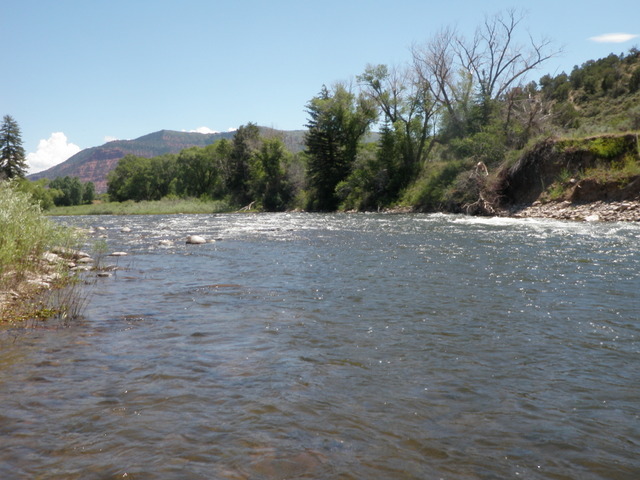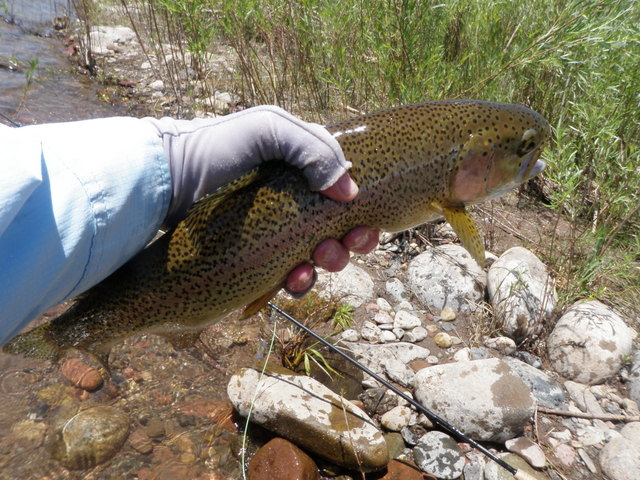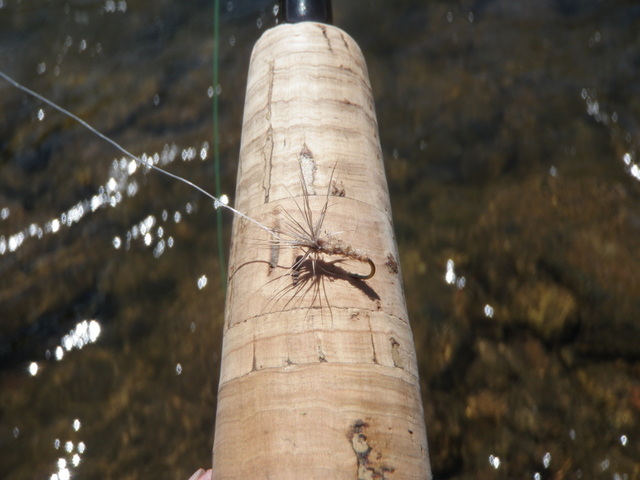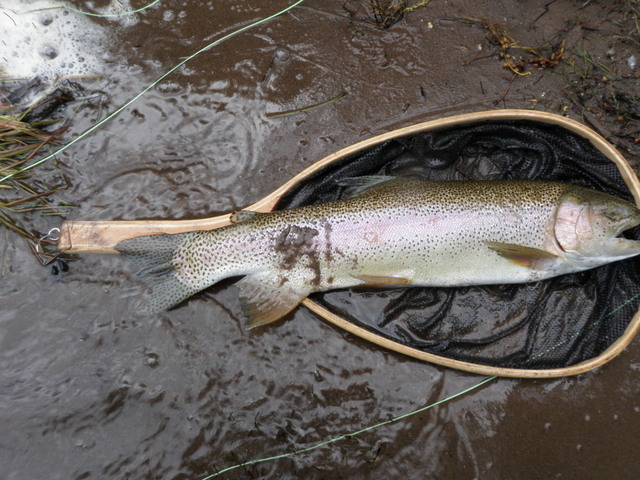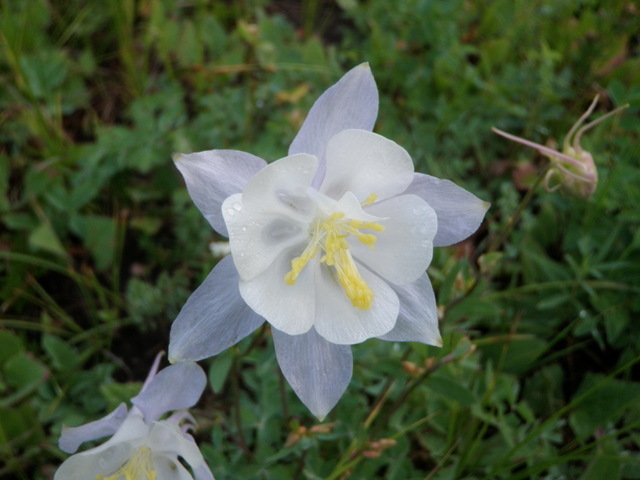Time: 12:00PM – 5:00PM
Location: Third set of steps over the fence in Eagle Lease when traveling west on route 6 upstream to the second set of steps
Fish Landed: 14
Eagle River 07/10/2014 Photo Album
Despite landing 16 fish in 5.5 hours of fishing on Wednesday afternoon on the Arkansas River, I rolled the dice and drove three hours to the Eagle River. Would this be a colossal blunder or a stroke of genius? I traded a relative known for the notoriously temperamental Eagle River.
I underestimated the time it would take to make the trip, as I encountered a variety of obstacles along my way. First there was the unexpected wait for road construction west of Salida. I should have factored in all the small towns along the way and the associated slow speed limits, and it should have been obvious that I would follow countless out of state recreational vehicles slowly negotiating every minor curve between Salida and Eagle. I also stopped for fuel and ice, and as I reached Hornsilver Campground, I took extra time to pick a campsite and pay my fee for Thursday night.
I planned to begin fishing in the middle of the Eagle lease just east of Eagle, CO where Dave G. and I ended on Saturday afternoon, and when I arrived there, two cars occupied the wide pullout in front of the fisherman steps that arched over the fence. This caused me some concern regarding competing fishermen, but I went beyond them, and executed a U-turn, and parked twenty yards west of the access point. My paranoia caused me to speculate that too many fishermen were reading my blog and flocking to my favorite spots.
It was another hot sunny day and the flows had dropped from 900 cfs to 600 cfs in the five days since I’d enjoyed success, so I was a bit concerned that the warm temperatures might impact the fishing. By the time I prepared to fish and climbed the stairs and walked to the edge of the river, it was noon. I began with the traditional Chernobyl ant and beadhead hares ear, but I didn’t enjoy any action for 15 minutes or so. Fortunately as doubts about my decision began to creep into my head, I began to observe some pale morning duns riding the surface of the river. The hatch was relatively sparse at first and consequently no fish were rising, so I elected to stick with the hares ear nymph, but I added a salvation nymph hoping that it would imitate the nymph stage of a pale morning dun mayfly.
The intensity of the hatch increased, and I began to observe bulges from the backs of the fish breaking the water surface. This is typically a sign that the fish are taking subsurface emergers, so I began giving my nymphs more movement, but this tactic failed to generate any action. My frustration was beginning to build as the hatch moved into full bloom, and I was on the outside looking in. At this point, however, a few surface rises developed so I decided to abandon the subsurface approach and try a single dry fly. I removed the three fly dry/dropper configuration and tied on a size 16 gray comparadun, and it took quite a bit of persistent casting, but I eventually landed two medium rainbows.
I was pleased with this hard earned success, but again a lull occurred and the gray comparadun was ignored even though I placed some nice casts over fish that continued feeding. In fact, with the aid of my polarized sunglasses, I could see that several of the risers were nice sized trout. I decided to switch to a cinnamon comparadun that I tied over the winter to imitate the PMD’s that hatch on the Frying Pan River. This turned out to be a solid move, as I landed three more rainbows from the wide riffle, and one was a very nice 15 inch bow that I spotted subsurface. I cast to this fish repeatedly before finally enticing a take. The strong pale morning dun hatch lasted for an hour, and I managed to land five nice rainbows, so I was starting to feel better about my decision to abandon the Arkansas River.
Once the hatch ended at around 1PM, I reverted to the dry/dropper approach but used a Charlie Boy hopper as my top fly with a beadhead hares ear and salvation nymph as my two droppers. The surface fly wasn’t attracting interest, and I have a lot of Charlie Boy hoppers that I tied two winters ago, so I decided to put them at risk rather than the pool toys of which of have fewer to lose, and they take longer to make. During the post-hatch time period I landed a gorgeous brown trout that measured 17 inches, and this fish carried a lot of weight. As you might expect, this fish put up quite a fight, and in order to land it, I followed it downstream a bit and then angled it to shore.
I increased my catch total from five to nine after the hatch, as I picked up fish at a fairly regular rate, and next I approached another beautiful wide riffle that ran over a rocky bottom with three to four feet of depth. I paused to observe and quickly noticed several rises and upon closer examination with my polarized sunglasses spotted some nice fish holding along the river bottom. One particular fish appeared to be quite large, so I decided to focus on it and began to cycle through a series of flies. On an early drift over the target fish, it appeared to show interest in the hopper, but backed away, and the nymphs seemed to be useless. I removed the three fly dry/dropper arrangement and tried a gray size 12 stimulator next, but this didn’t even generate a look or tail twitch. A green trude was introduced to the big guy next, and the trout rose a bit and inspected but returned to its holding position. Perhaps a small caddis similar to the ones I saw over the water would do the trick? I tried a size 16 gray caddis next, but that was scorned by Mr. Trout. What about a PMD? Some stragglers continued to emerge and drift on the water, but nowhere near the number that were present during the prime time of 12-1PM. It was worth a try, so I tied on a brand new cinnamon comparadun since the one I used earlier no longer had tails and was unraveling a bit.
I cast above the fish and as it drifted by slightly to the right, the big boy casually swam over a foot or so and sipped in my fly! It is moments like this that keep me coming back to this sport. I fought the fish for a bit, but it didn’t put up as much fight as the 17 inch brown. I carefully waded to the bank and kept the big rainbow in the water until I had my camera ready, and then positioned my net and the fish on a flat area. Unfortunately the rainbow made a last ditch effort to escape and rolled in some sand, so that when I repositioned for a photo, it was marred by a clump of sand and dirt. Still it was perhaps my biggest fish of the year and extended beyond my 15 inch net opening by at least 3-4 inches.
With my heart still racing I continued on along the north bank prospecting with the dry/dropper and landed four more fish. The last fish near my quitting point was a rainbow that took a pheasant tail nymph that I substituted for the salvation nymph in hopes of preserving my dwindling supply.
In summary it was a fun day on the Eagle River in the Eagle lease section. The fish were more spread out than on July 5, but this gave me a chance to fish to a decent hatch and do some enjoyable sight fishing. My catch ratio was roughly 60% rainbows and 40% brown trout, and I enjoy having the opportunity to catch rainbows in a predominantly brown trout state. Fourteen fish landed is quite respectable, and the average size of the fish was superior to what I was catching on the Arkansas River on Wednesday. I concluded that my move to the Eagle River on Thursday was well worth the drive..

